2012.06.12 14:36
Why is architectural theory so hard to read?
Lotus International 19 happens to be the first Lotus magazine I ever bought, so its contents are (still) fairly well ingrained within my memory. Looking over "Cities within the city" (again) last night reminded me of another subsequent Ungers essay--"Architecture of the Collective Memory"--also published within Lotus, this time Lotus International 24 (1979). I personally remember this essay as something I really connected with, something that I really liked the idea of, but I don't think I've (re)read the essay in many years. Of course, I reread "Architecture of the Collective Memory--The infinite catalogue of urban forms" last night, and wow, it like blew me away because what Ungers relates is exactly how I've come to see Piranesi's Ichnographia Campus Martius, that is, as a whole city of architecture of collective memory, indeed an infinite catalogue of urban forms (e.g. 3123h, 3123i, 3123j, 3123k). Interestingly, such a view of the Ichnographia Campus Martius is what Aureli (and Eisenman) do not (want [you] to) see the Ichnographia Campus Martius as.
Being restless, I continued to read more of The Possibility of Absolute Architecture. I read the Boullèe chapter and started the Ungers/OMA chapter (five). Ten pages into chapter five you encounter material on the Havellandshaft, which is how Ungers ends "Architecture of the Collective Memory," yet Aureli no where mentions the "collective memory" aspect of the Havellandshaft (nor does Aureli footnote reference "Architecture of the Collective Memory--The infinite catalogue of urban forms" in Lotus International 24).
I now feel inspired to write a book entitled The Reality of Convenient Memory Architecture, theory even.
"Architecture of the Collective Memory" begins with these passages:
In his book Invisible Cities Italo Calvino invented an imaginary conversation between the Venetian traveler Marco Polo and the great emperor of a distant country. "At this point Kublai Khan interrupted him or imagined interrupting him, or Marco Polo imagined himself interrupted, with a question such as: 'You advance always with your head turned back?' or 'Is what you see always behind you?' or rather 'Does your journey take place only in the past?'"
All this so that Marco Polo could explain or imagine explaining or succeed finally in explaining to himself that what he sought was always something lying ahead, and even if it was a matter of the past it was a past that changed gradually as he advanced on his journey, because the traveler's past changes according to the route he has followed: not the immediate past, that is, to which each day that goes by adds a day, but the more remote past. Arriving at each new city, the traveler finds again a past of his that he did not know he had: the foreigness of what you no longer are or no longer possess lies in wait for you in foreign unpossessed places.
2012.07.17 14:20
koolhaas' Junkspace
...your answer is a masturbatory game itself, and has nothing to do with the foundations of Post-Modern Architecture.
Here's one better answer, from a lecture given by Robert Stern, February 18, 1975:
"...Diversity, heterogeneity, even eclecticism can now be spoken as the watchwords of post-modern architecture.
A confluence of events seems to mark this movement from the exclusionist neoclassicism of the late 1950s--still with us today in the work of such firms as Skidmore, Owings & Merrill--to the more inclusive, contextual, sometimes even ad-hoc work of the Venturis, Charles Moore, Aldo Giurgola, and their followers, among whom I number myself.
The so-called post-modern architecture of this group is now coming into its own style--or at least as an attitude, shedding its negative, anti-establishment tone and growing self-confident with its point of view. While not exactly a new establishment, it can be claimed to be, for the moment at least, a kind of institutionalized counterculture.
Before attempting to explain post-modern architecture I would like to make clear that the term post-modern is, in my mind at least, not a proper critical or art historical term at all but simply a convenient description for an attitude which I believe to be emerging and valid. This attitude can be described as cultural and historical inclusiveness; and as such it opens up for discussion the fundamental tenets of what for fifty years or more has been regarded as the Modern Movement in architecture."
Your answer is probably better aimed at what Peter Eisenman, in 1975, labeled as his position--"post-functionalism" See the opening of Stern's 1981 "Notes on Post-Modernism" for the full story.
| |
2012.07.17 17:06
koolhaas' Junkspace
Again from Stern's "Notes on Post-Modernism"...
By post-modern, I believe Eisenman really meant anti-Modern Movement; moreover, I think he hoped it might also be against the Western humanist tradition. But as I hope to demonstrate, and as I see it, the term postmodern really describes a condition that comes after and is in reaction to the Modern Movement, and attempts to effect a synthesis between it and other strains of the Western humanist tradition.
If you look at the architecture that subsequently became the foundation of Post-Modern Architecture, you indeed do see a synthesis between the Modern Movement and other (older and/or concurrent) strains of the Western humanist tradition.
Conversely, Junkspace is not a synthesis, but rather a by-product, an undesigned residue paradoxically emanating from our ever-expanding (overly?) designed built environment. Junkspace is there although no one specifically designed it, yet it might not be there so much if designers weren't so intent on designing everything[?].
12121902 Wall House 2 model
Peter Eisenman, "Eisenman's Doubt" in Log 13/14 (Fall 2008), pp. 185-91.
2013.01.06 14:00
5 January
All along it's been an investigation, finding out what it's like to design along these lines. And, just recently, I've taken up the investigation again. Regarding the Eisenman/trace connection, what I think relates there is that I'm designing exclusively within a CAD environment--there are no sketches, drawings, physical models--it's all done just within the 'machine'. Of course I create fresh (digital) data, but much of the design work is a manipulation of existing data, and inspiration often comes from overlapping data in simultaneous 2D and 3D, seeing things from any angle, wireframe or solid, etc. The roof plan as paving idea, for example, occurred late Friday night when I was checking to see how the jumble of upper 'cubes' relate to the ground plan in plan view. 3301b
2013.05.16 11:32
FRANK GEHRY AT WORK on View in New York City
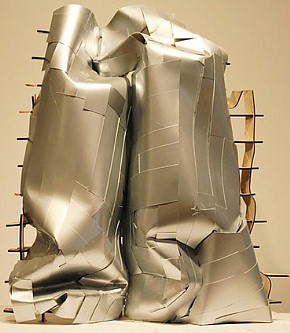
Remember Eisenman's September 2002 proposal for new towers adjacent Ground Zero?
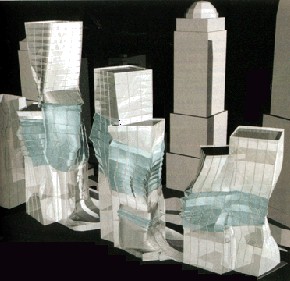
I don't have any books on Gehry post 1999, so I still have to investigate what Gehry was doing circa 2002. Actually, there is a more recent book I can get from the Free Library. I have a feeling that Eisenman was ahead of Gehry with regard to the whole crumbling/falling-down look/form.
Will history come to acknowledge the events of 9-11 as having a significant effect on early 21st century architectural form?
| |
2013.05.16 21:19
FRANK GEHRY AT WORK on View in New York City
I used the word crumble (with a 'b'), and you used the word crumple (with a 'p'), and they are not the same thing. Yes, the crumple (ie, scrunch together) has been a part of Gehry's design vocabulary since the late nineties, but the crumble (ie, erode, fall apart) is much more recent in Gehry's work. It might well be significant that Eisenman's 2002 design is a combination of crumple and crumble.
2013.06.27
architecture's self-reflective dialectic
"In the process of demonstrating the open-endedness of architecture's self-reflective dialectic as well as its fictitious beginnings, Eisenman analytically "read" a series of architects throughout his career, whose structures would disintegrate into radically self-contradictory configurations in the process: Andrea Palladio, Giambattista [sic] Piranesi, and Giuseppe Terragni were his main critical templates to corroborate that the discipline had always hinted at an awareness of its paradoxical foundations; the critical dimension of architecture was just less subdued with these architects, and hence their analyses released the whole (ironic) critical-constructive paradoxes of architecture. For example, in his etchings for a map of the Campo Marzio dell'antica Roma from 1762, Piranesi had proliferated the classical compositional logic of architecture to a point where his two-dimensional plan could no longer correspond to the three-dimensional ideal of a "classical" urban space; Piranesi had created a formal hyperbole out of the accepted rules of classical composition only to demonstrate the logical collapse of these very rules. Piranesi "concretized" the idea of language's sublime open-endedness into a physical reality that took on characteristics of the grotesque: "Whereas the sublime deals with qualities of the airy, qualities which resist physical occupation," Eisenman argued, "the grotesque deals with real substance, with the manifestation of the uncertain in the physical." With Piranesi, classical architecture used its own mechanism for self-annihilation--in a sense, it "swallowed its own stomach." Alongside Piranesi, Eisenman also made Palladio and Terragni into demonstrations of the breakdown of the established architectural canon at their respective moments in time. He rhetorically fleshed out their formal "disturbances" in the accepted compositional standards of architecture and propagated them ad nauseam into self-contradictory diagrams of formal fragments. Once again the temporal dialectic of postulation and refutation was in and of itself materialized as "architecture.""
Emmanuel Petit, Irony or, the Self-Critical Opacity of Postmodern Architecture (New Haven: Yale University Press, 2013), p. 175.
Petit's explanation of Eisenman's analysis of Piranesi's Ichnographia Campus Martius is really only a paraphrasical reiteration of Tafuri's critique of the Campo Marzio plan. Furthermore, Eisenman's quote regarding the sublime stems from a text that has nothing directly to do with Piranesi and/or the Campo Marzio plan.
Nonetheless, Petit's explanation raises various questions, such as:
What is "the classical compositional logic of architecture" and how exactly did Piranesi proliferate the classical compositional logic of architecture?"
What is "the three-dimensional ideal of a "classical" urban space" that Piranesi's two-dimensional plan could no longer correspond to?
If Piranesi did indeed create "a formal hyperbole out of the accepted rules of classical composition," then how exactly did he then simultaneously "demonstrate the logical collapse of these very rules?"
Once again, it is really only Tafuri who ever attempts to substantiate the above claims regarding what Piranesi supposedly did via the Campo Marzio, yet even Tafuri's 'evidence' does not rightly correspond with what is actually present within Piranesi's large plan.
So then, what exactly do the superfluity of Piranesi's original building plans within the Ichnographia Campus Martius signify, disclose, communicate and represent? What were the ingredients of inspiration, and what prompted this burst of planimetric imagination in the first place? Appropriately enough, a nascent answer to these questions comes from Piranesi himself, where, in the dedication to the Campo Marzio, he cites the Forma Urbis, Hadrian's Villa and more as exemplars:
I am rather afraid that parts of the Campus which I describe should seem figments of my imagination and not based on any evidence: certainly if anyone compares them with the architectural theory of the ancients he will see that they differ greatly from it and are actually closer to the usage of our own times. But before anyone accuses me of falsehood, he should I beg, examine the ancient [Marble] plan of the city . . . he should examine the villas of Latium and that of Hadrian at Tivoli, the baths, the tombs and other ruins outside the Porta Capens and he will find that the ancients transgressed the strict rules of architecture just as much as the moderns. Perhaps it is inevitable and a general rule that the arts on reaching a peak should decline, or perhaps it is part of man's nature to demand some licience in creative expression as in other things which we sometimes criticise in buildings of our times.
Thus, following Piranesi's lead, the investigation commences.
dialectic 1 : the theory and practice of weighing and reconciling juxtaposed or contradictory arguments for the purpose of arriving at truth esp. through discussion and debate
| |
2013.09.23 09:37
23 September
"I certainly have my uncharted territories."
...and I felt very fortunate to begin reading the third book "Joseph in Egypt" while on my first trip to LA, September 1982--there was an uncanny commonality between both 'events'. Was Eutropia at Trier on 23 September 326? Is that when she (metabolically) gave orders for the destruction of the Imperial palace there to then create the enormous twin basilica in its place?
"Perhaps Constantine should have mentioned that I didn't send the letter about Mamre from Mamre. Perhaps Constantine knew he was 'oaking' at the expense of modern doubters."
Yelling loudly, the 35-year-old woman attacked "Office Baroque," a cutout section of wall by American artist Gordon Matta-Clark, doing a series of head-over-heels flips before landing on the work in a handstand, punching both her arms through the drywall... She then ran across the large room, pushing over a section of a spray-painted truck called "Graffiti Truck," also by Matta-Clark, bending back the metal roof.
"There is an artist that devised a machine that 'reenacts' the human digestive system, which ultimately produces turds."
At the very end of the video interview of Peter Eisenman in conjunction with the latest Venice Biennale, the architect makes reference to "Kafka's Magic Mountain," as in hopefully the architect's project of a City of Culture at Santiago de Compostela will find a happy artistic commonality with Kafka's Magic Mountain. Maybe Eisenman is knowledgeable of some manuscript that Kafka himself destroyed (as Kafka did destroy some of his own manuscripts), but otherwise it was Thomas Mann that wrote The Magic Mountain.
"Yes, let's hear it for [some] contemporary architecture and [it's knowledge of] culture!"
Take a look at Le Corbusier's Palais des Congrès à Strasbourg (1964), and then look at OMA's Hotel at Agadir, the Library at Jussieu, the Educatorium, and then MVRDV's VPRO--a trail of design reenactments. Maas worked on the OMA projects. Right now it looks like the novel begins at the Hotel of the Palais des Congrès. All the architects are registered there for the "Turning the Labyrinth Inside-Out" conference. None of them is confident, however, that the 'Buildings Present Themselves' portion will proceed without a variety of embarassing technical glitches.
"His last word to me (sixteen years ago today) was "battery."
twelve eleven ten
nine eight seven six five four
three two one zero
2013.12.22 15:16
What is an experimental architect? Are Zumtor and Herzog experimental?
experiment 1b (1) : a tentative procedure or policy; esp : one adopted in uncertainty as to whether it will answer the desired purpose or bring about the desired result
experiment 4 : the process or practice of trying or testing
experimental 2 : founded on, derived from, or discovered by experiment
Given the above definitions, Frank Gehry is probably the leading experimental architect of the last 35 years or so.
2008.08.23 15:16
peter's canon
One thing that crossed my mind last night was how, when I see the many studiy models of H&dM...
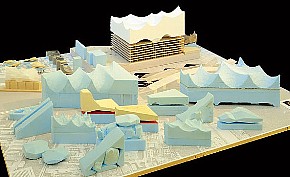
...and OMA...
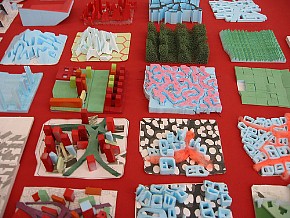
...I'm reminded of the many study models produced by Gehry for the Lewis Residence...
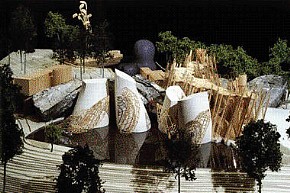
I may be stretching it, but...)
Gehry's method of design via innumerable study models [ie, experimentation] seems to have become quite influential.
[The following is an experiment. In the two passages below, the word experimental replaces the original word pliant, and the word experimentation replaces the original word pliancy.]
2008.08.23 21:06
peter's canon
Personally, I like seeing all the study models of various projects by various architects. I like it because it clearly demonstrates just how experimental architectural designing can be. And I seriously consider the notion that it may well be Gehry that best introduced architectonic experimentation to the profession.
Is architectonic experimentation in somewhat sharp contrast to Eisenman's method? Up to a certain point (in time) I'd say yes. And when Eisenman's work started exhibiting some measure of experimentation, that's where I start to see Gehry's influence.
| |
2014.03.17 13:22
17 March
Coincidentally typed this morning:
There is a profound "immobility" in the technological world which science fiction writers have often portrayed as the reduction of every experience of reality to an experience of images (no one ever really meets anyone else; instead, everyone watches everything on a television screen while alone at home). This same phenomenon can already be sensed in the air-conditioned, muffled silence in which computers work.
Flattened out, simultaneous, the world appears de-historicized. What made up "modern"--i.e. the experience of living every day in a narrative history of progress and development reinforced by the daily newspaper--now comes to a halt. The "master" narrative, once a secularization of religious salvation, now fails, and multiple other possible narratives rise up."
Gianni Vattimo, quoted in "Postmodern or Posthistoire?"
I still have to scale it with a map, but Kahn's burial plot is somewhere in the top left quadrant, maybe just within the western edge of Campo Rovine.
Are the Koolhaas/OMA instances of Ichnographia Campus Martius usage also examples of "history flattened"? Is the Ichnographia Campus Martius itself an example of "history flattened"?
Read again last night the Vidler/Eisenman conversation in Log 28. Vattimo came up a bit.
It's becoming more and more clear that lots of the fuel that burned Tafuri's contemporary-architecture-critique fire came from Scully's early 1960s writings. And, judging from a comment I once saw/heard Scully make about Tafuri, I think he [Scully] already knew it.
2014.05.14 13.16
14 May
Coincidentally, one of the items the mailman delivered today was a copy of Tracing Eisenman, which I successfully/cheaply bid on last week. To my surprise, the book is signed by Peter Eisenman himself, twice even.
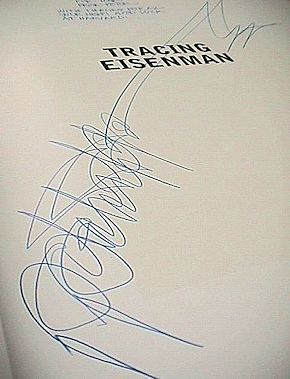
Get it? Peter Eisenman tracing Peter Eisenman, literally.
2015.02.05
I scanned "Eisenman's Doubt" from Log 13/14 (Fall 2008) because I saw a connection to some of my designs at Quondam, the using of three dimensional representations as two dimensional plans, e.g. the New Not There City master plan.
2016.05.27 15:07
"Technology is a cruel tool" -Peter Eisenman
"The student can take an algorithm, produce 50 alternatives to the same problem … It takes away from you the possibility of value judgment."
What exactly is the evidence that the "possibility of value judgment" has been taken away? And how exactly is such evidence manifest?
For Eisenman's damning statement to be true, you'd think there would at least be a load of evidence to back it up.
2016.05.28 10:38
"Technology is a cruel tool" -Peter Eisenman
Eisenman uses 'resistance' as an example of something that cannot be attained through a design algorithm, thus inferring that a design of 'resistance' can only be attained via designing without the aid of a computer(?). He's just making something sound important when, in fact, it's nothing important at all.
It's fine if Eisenman chooses to design with the intention of manifesting resistance, but his design choices have no bearing at all on how one designs while using algorithms. Again, all he's really doing is trying to make the way he designs more important than the way students (supposedly) design via algorithms today.
Essentially, everything that Eisenman here riles against is just a straw man set up to make his way of doing things appear more important.
2016.10.06 20:40
Architecture Without Reference
Eisenman's Berlin tower is basically an extreme arch, whereas CCTV is a 3D loop with an extreme cantilever. They're two very different things, and there really is no precedent for what CCTV does as a building (even if one might see a reference to Eisenman's Berlin tower).
|